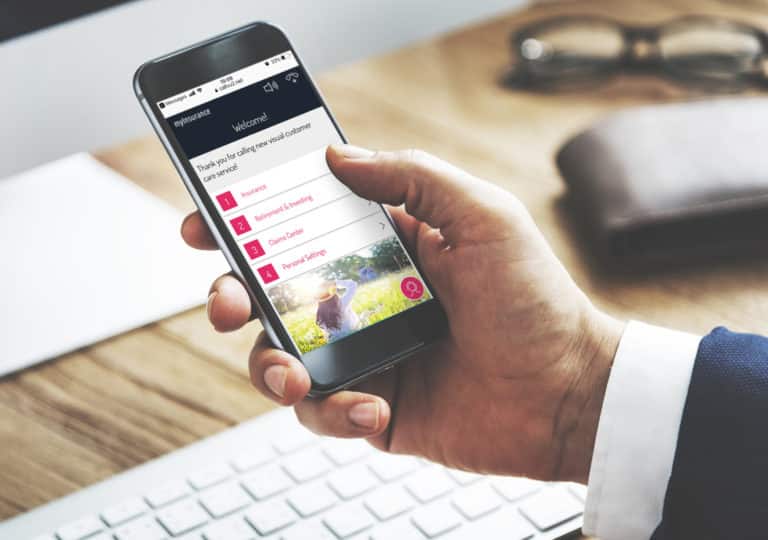IVR has both an image and a reality problem. Is there anyone out there that thinks traditional IVR is as good as it can be? Fortunately, visual IVR and conversational IVR are driving change in this critical customer service arena.
From a customer’s perspective, calling into a contact center has changed little in decades. That is because most companies still utilize antiquated Interactive Voice Response (IVR) systems. These voice IVR systems can be challenging to use, leading most customers to some frustration because they receive a slow and inefficient experience.
Recent advancements in IVR are providing new ways for customers to engage with your company over the phone in self-service, dramatically reducing the friction created by a traditional IVR system. Two IVR innovations lead the way in modernizing contact centers with more robust self-service options, Conversational IVR and Visual IVR. Companies seeking to provide a superior caller experience must determine which drives the most significant improvement in customer experience while driving down call center costs for their organization.
In this post, we’ll cover why visual interactive voice response (Visual IVR) and visual IVR applications deliver the most seamless, robust, and cost-effective customer experience. We’ll cover five key IVR and digital channel topics:
- The drawbacks of traditional IVR
- The difference between Conversational IVR and Visual IVR
- Why Visual IVR provides a superior customer experience
- Benefits of Visual IVR for your contact center
- The disadvantages of traditional IVR
THE DRAWBACKS OF TRADITIONAL IVR
Traditional IVR systems are the “front door” to most call centers and contact centers. These touch-tone and directed dialog-based IVR systems allow inbound calls to reach the correct department. They can also enable some very simple self-service capabilities like checking an account balance. However, the complicated menu trees and script details can be challenging to navigate, and it can take a long time to reach the desired task or call routing. This may have been a valuable solution in an analog world but no longer drives acceptable levels of customer satisfaction with digitally-savvy consumers who expect a more efficient and streamlined customer journey.
The heart of the problem lies with Traditional IVR’s reliance on very basic touch-tone/dial pad audio inputs. This greatly restricts traditional IVR interactions. Not only is the process slow, but it is also unfamiliar and error-prone. Many people avoid it altogether by dialing “0” or saying “speak with a contact center agent” to bypass the IVR automation and speak with a live agent. This, of course, defeats the entire purpose, removing any possibility of call containment and putting a greater onus on live agents – the most expensive resource of any customer support department.
Recent innovations in IVR can deliver a far superior customer experience while dramatically increasing contact center efficiency. We will look at the two most prominent, Conversational IVR and Visual IVR, to determine the best for your business.
DIFFERENCES BETWEEN CONVERSATIONAL IVR AND VISUAL IVR
Both Conversational IVR and Visual IVR provide new modes of engaging with automated self-service systems. Conversational IVR is focused on enabling a greater range of voice commands, while Visual IVR overlays a digital experience onto the call to allow app-like engagement. Visual IVR experiences are typically delivered through links texted or pushed to the caller’s mobile device, leveraging its smartphone power as both a voice and browser-based tool.
Conversational IVR and Visual IVR offer unique capabilities and benefits:
Conversational IVR
Conversational IVR aims to provide more human-like interactions in self-service customer experiences. It does this by allowing customers to use more complex voice commands to navigate the menu options and capabilities of the self-service experience. Conversational IVR uses a type of artificial intelligence and machine learning known as Natural Language Processing (also known as natural language understanding) to determine the intent of customer commands, predict why they are calling, and direct them to the necessary capabilities and resources to resolve issues.
Visual IVR
Visual IVR uses web applications to deliver an app-like self-service experience for users during contact center interactions. The experience usually starts with a text or push notification containing a link. Customers then interact with a visual interface to select from menu options, review account details, digitally enter information, and more. While Visual IVR offers many of the same benefits as a mobile app, it avoids virtually all of the customer adoption hurdles.
WHY VISUAL IVR IS BEST FOR YOUR CUSTOMERS AND BUSINESS
Both Conversational IVR and Visual IVR provide callers with new modes of engaging with self-service systems. Conversational IVR significantly enhances the ability to use speech to navigate IVR menu options and complete tasks. Speaking is the most natural way for humans to communicate, so the appeal of Conversational AI is clear. However, a recent study by Sitel Group shows that 70% of consumers prefer not to speak to a virtual assistant or chatbot in customer service scenarios, with nearly half citing that they don’t trust a bot’s ability to understand their needs accurately. Another report from CGS, shows that 86% of people prefer live chat to bot chat for this same reason.
While natural language processing is improving speech recognition all the time, relying on virtual assistants and chatbots to understand customer needs, intent, and urgency can be challenging and risky. Conversational IVR platforms often require some level of human intervention when customer intent can’t be easily determined.
New Vector of Engagement
Visual IVR experience goes beyond increasing the effectiveness of audio and speech inputs that can be used to engage with IVR systems; it opens an entirely new vector of engagement – the visual digital experience. Today’s consumers have become extremely comfortable interacting with digital interfaces. Visual IVR not only makes it easy to navigate menu options, the digital interface dramatically increases the number and complexity of services that can be offered in self-serve. Most Visual IVR implementations can take advantage of digital assets and capabilities that have already been developed by a company.
Virtually anything that has been built into an app or website can be delivered into the voice channel and accessed in real-time by calling customers. So while Conversational IVR and Visual IVR both make it easier for a customer to navigate automated self-serve systems, only Visual IVR can allow customers to handle more tasks that typically require a live agent call in self-serve. That visual menu can be a boon to the self-service option you offer your customers.
BENEFITS OF VISUAL IVR FOR YOUR CONTACT CENTER
Visual IVR technology empowers customers to service more of their needs quickly, improving customer satisfaction, but it also drives significant cost savings and efficiency increases.
Lower costs and free agents to focus on high-value work
The cost of a live agent customer service phone call can be staggering. For companies handling thousands of calls per month, the contact center is a substantial financial outlay. By increasing call containment, companies can significantly lower their call volumes and related costs. Because a Visual IVR application contains calls with simple requests, agents are free to focus on adding the most value on selling and resolving complex issues.
Get customers the help and answers they need faster
Visual interactive voice response helps get customers answers to their questions and resolution to needs fast without holding for a live agent. A Visual IVR system can reduce Average Handle Time (AHT) over traditional and Conversational IVR because information can be communicated visually far more quickly than with audio alone. A Visual IVR solution scales easily, handling more calls and adding new self-serve capabilities as needed to serve as many customers as quickly as possible.
Improved customer experience and higher customer satisfaction (CSAT)
Visual interactive voice response can augment traditional and Conversational IVR systems, giving customers the choice to interact with self-serve systems with touch, voice, or both. FICX customers who implement Visual IVR see high digital opt-in and significant increases in their net promoter score (NPS). When you empower customers by giving them choice and removing friction from their interactions with your brand, you’ll see the benefits across many customer service metrics, especially customer satisfaction.
Visual IVR – part of a better, holistic customer experience
Phone calls are just one of the ways that companies interact with customers and prospects. At FICX, we focus on ensuring that customers get a great experience with your brand and company in whatever way they choose to interact. Offering customers more and optimized options can have a tremendously positive impact on the overall brand experience. By providing visual content in multiple flows (via phone, in-app, online, and at retail/on-premise,) you can improve customer understanding and reflect the insight that visual information is often more pleasing and easier to understand for your customers.For more information on FICX and our solutions, visit our site or request a demo.





